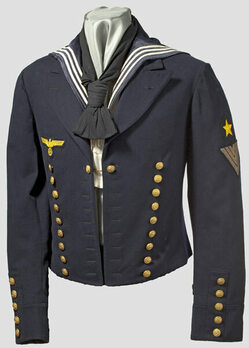Kriegsmarine Parade Jacket
CATEGORY: Version
SKU: 21.GOR.02.01.03.004.000
Estimated market value:

Estimated market value:
The headgear, uniforms, and insignia worn by members of the Kriegsmarine were based upon the designs utilized by the Kaiserliche Marine (Imperial Navy) and the Reichsmarine (Navy of the Weimar Republic). The official regulations governing the uniforms of the Reichsmarine were issued on April 5, 1921, and they were embraced, with a few alterations, as the Kriegsmarine uniforms in 1935.
From 1933 to 1945, the uniforms worn by personnel in the German Navy were produced and disseminated by the Navy Clothing Depot and private manufacturers. The cloth was of a high quality prior to the Second World War, but during the war, it became increasingly synthetic and of lower quality. Similarly, the cloth used in the uniforms of Officers and Admirals was of a higher quality than the cloth used in the uniforms of lower ranking personnel, such as Non-Commissioned Officers and Enlisted Men. The cloth utilized in garments of the blue uniform is of an overall better quality than the cloth utilized in the field-grey uniform. For the field-grey uniform specifically, the cloth is more grey-coloured in pre-war uniforms, while the cloth is more green/olive-coloured in wartime uniforms.
The main colour of Kriegsmarine uniform pieces is a dark navy blue. However, during the summer months, and initially also in regions with warmer climate, a white summer uniform was used. Eventually, a brown tropical uniform was introduced for units stationed in tropical and subtropical regions. Land-based Kriegsmarine units, most of which were part of the Coastal Artillery, wore Army-like field-grey uniforms in the style of the Kriegsmarine.
The garments may have proof stamps, serial and unit stamps, and manufacturer marks denoting the legitimacy and origin of the item. They also tend to feature sewn name tabs (Namensläppchen) on all clothing items associated with the blue and field-grey uniforms. The blue uniform garments all have a serial number stamp (Stammrollennummernstempel), while the field-grey uniform garments have a unit stamp.
The proof stamp is present on all garments produced by the Navy Clothing Depot, and it includes the size of the item, if needed, with the year of manufacture above the size, and a surmounting script that reads “B.A.K.” or “B.A.W.”. This stamp information is framed, and written in white ink on blue or black garments and in black ink on all other colour garments.
The serial stamp is composed of letters and numbers, and it is present on blue uniform garments from the Depot. The stamp is either printed in red ink or sewn in red thread. The numbers are preceded by a letter that denotes the area in which the wearer served, with an “N” for Navy Station or an “O” for Navy Station Baltic. The stamp ends in a letter associated with the wearer’s career group, with an “S” for deck personnel and a “T” for technical professionals. Below the serial number is the year in which the wearer entered the navy, surmounted by a horizontal line.
The unit stamp is present on field-grey uniforms. It includes the framed, shortened unit name of the wearer in red ink.
The marks of private manufacturers vary widely, ranging from codes to full names, and even abbreviated letters, as well as the year of manufacture. After 1942, Reich numbers (Reichsbetriebsnummern) were also used as manufacturer marks (RB-).
The buttons worn on Kriegsmarine garments are generally gold-coloured, except for the uniforms of Officials which used silver-coloured buttons. The buttons feature the image of a fouled anchor on the obverse. The buttons are composed of brass, or of light metal. The gold-coloured buttons were gilded, while the silver-coloured buttons were silvered. As well, in the case of special uniform garments the buttons may be composed of plastic.
The Parade Jackets are a form of short jacket, and they were primarily worn as part of the Kriegsmarine parade attire and the walking-out dress. They were also worn with the service dress when ordered.
These jackets were permitted for wear by Junior Non-Commissioned Officers and Privates, but in April 1934, a slightly altered form of the jacket was made available to Kriegsmarine Cadets. While the Cadet jackets were replaced by the Reefer Jacket in May 1936, all parade jackets were prohibited from wear, unless ordered otherwise, by a new regulation introduced in September 1939.
The parade jackets are composed of several main elements, including the cloth, the lining, the buttons, the sleeves, the national emblem, the career insignia, and the rank insignia.
The jackets are composed of navy-blue wool/wool-like cloth, with fine-quality cloth used for Cadet jackets. The lining was made from dark cloth for the body of the jacket, and white/off-white cloth for the sleeves.
These jackets feature a total of 30 gold-coloured (gilt) anchor buttons. Each front panel has a row of nine buttons down the middle, and there are two buttons located directly below the lapels that are linked by a gold-coloured chain. There are also five buttons on each jacket sleeve, and two buttons hidden below the collar.
The jacket sleeves were composed of two panels, with seams along the front and back. The front of the sleeves feature a row of five buttons, and 50mm outward from the front seam is a patch of basic cloth. For Junior Non-Commissioned Officer, an additional tress border was added along the top of the sleeve cuff and the outside of the basic cloth patch.
The national emblem is located on the front right panel, directly above the row of anchor buttons, while the career and rank insignia, including chevrons, are featured on the left sleeve. See the Career Insignia and Chevrons sections for more information.

Comments
Sign in to comment and reply.


Scroll Top